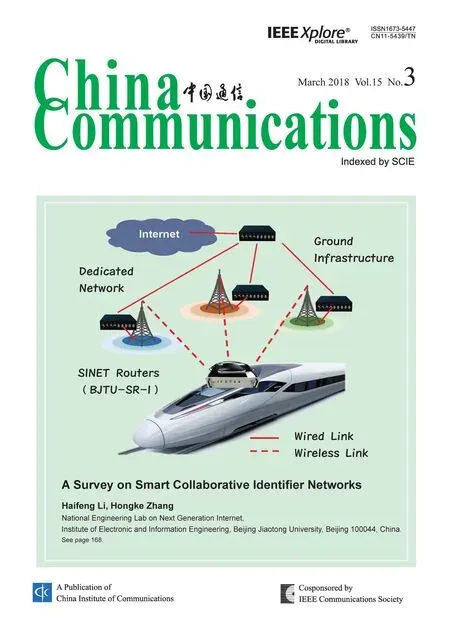Beamforming and Interference Cancellation for D2D Communication Assisted by Two-Way Decode-and-Forward Relay Node
2018-04-04YiyangNiJieZhaoYuxiWangHongboZhu
Yiyang Ni*, Jie Zhao, Yuxi Wang, Hongbo Zhu
1 Jiangsu Second Normal University, Nanjing 210013, China; Key Laboratory of Wireless Communications of Jiangsu Province, Nanjing 210003, China
2 Jiangsu Second Normal University, Nanjing 210013, China
3 Nanjing University of Posts and Telecommunications, Nanjing 210003, China
* The corresponding author, email: cynthia_nyy@163.com
I. INTRODUCTION
In recent years, continuous development of online game, various innovative multi-media services and context-aware communication systems requires for higher spectral and energy efficient communications [1]. As the smart mobile devices popularize progressively, the demand for higher wireless transmission rate will become 1000 times than ten years ago[2]. However, the existing technologies such as IEEE802.11 and the 4-th generation (4G)mobile communication are limited by their infrastructures [3-5]. As the number of users increasing rapidly, the opportunity that the communication established within shorter distance will be greater. Device-to-device (D2D)communication underlaying the cellular networks has drawn great attention recently [6-9].
For the D2D communication, two users are allowed communicate with each other through a direct link [6]. With the short distance between two users, it can enhance the rate significantly and decrease the latency, as well as, the power consumption. What is more, the spectrum efficient can be improved potentially by reusing the same time-frequency resources with cellular users. Hence, researchers have made very great progress in their investigations on D2D communication [10-14].Meanwhile, relay-assisted communication has demonstrated great potential in enhancing the system performance [15,16]. Relay-assisted communication can obtain the space diversity gain without increasing the number of antennas or the transmit power of the receiver and can extend the coverage. One-way relay assisted system has been investigated in [17,18]which presented closed-form expressions for the system performance. However, one-way relay assisted system has low frequency utilization due to an extra time slot is required.Therefore, relaying technologies have been proposed for two-way communications [19].The system performance for two-way relaying system in Rayleigh fading environment has investigated in [20,21]. In order to get higher transmission rate, traditional D2D communication systems require reliable direct links between D2D users. Unfortunately, in practice,it exists many limitations for the transmission link between D2D users including poor propagation and large distance between D2D users,as well as, the interference between D2D link and cellular link. Motivated by these, many efforts have spent on the researches of the D2D communications aided by a relay node [22,23].The resource allocation, relay selection and resource group assignment were investigated for the relay-assisted D2D communication in [24,25]. A closed-form probability density function for D2D relaying system was derived in [26]. Note that the above works focus on the BS equipped with a single antenna where no BS precoding is considered for multiplexing and interference cancellation.
This paper investigates the device-to-device(D2D) communication underlaying cellular network assisted by a two-way decode-and-forward relay node.
However, in the future, multi-antenna BS will be deployed [27], which will share the same time-frequency resources. The system performance can be substantially enhanced by increasing the number of antennas at the BS.Due to these bene fits, efforts have been spent on investigating the D2D communication systems with multi-antenna BSs. Many works have focused on the uplink of D2D communication system with multi-antenna BS [28-32]. The authors of [28-30] proposed different efficient algorithms to maximize the sumrate of D2D users and cellular users based on different constraints. The approximate yet accurate closed-form expressions of the outage probability at the BS and D2D users were derived in [31]. [32] investigated the cellular and D2D spectral efficiencies under both perfect and imperfect CSI at the receivers employing partial zero-forcing on the uplink of D2D communication system. The downlink of D2D communication systems with multi-antenna BS has been also investigated in [33-38]. The authors of [33] investigated some precoder design methods and provided D2D pair association vector search algorithm to maximize the overall sum rate of cellular and D2D users,with regard to the continuous beamforming vector design. While [34] proposed algorithms to maximize the sum-of the achievable data rates of the D2D pairs with maintaining the QoS constraints on the cellular user. In order to maximize the capacity of cellular users, [35]presented two different MU-MIMO beamforming schemes to eliminate different interference, and then, generalized a user grouping and optimal power allocation algorithm. The authors of [36] provided a support-vector-machine-based algorithm to minimize the total transmit power of the devices while meeting the QoS requirement of both D2D and cellular users and suppressing the mutual interference to a certain level. The efficient algorithms were presented in [37] and [38] aiming to reduce the probability of users and improve the network throughput, respectively. Besides,relay-assisted D2D communication has attracted lots of attentions. The authors of [39]considered the D2D communication system in heterogeneous cellular networks where a femto user acts as a relay node and forwards to the macro user. The user relaying scheme with multiple antennas coordinated beamforming was provided to improve the performance of macro users. The scenario that the cellular users relay the messages from the BS to another cellular user under D2D model was considered in [40]. And then, a joint beamforming design to minimize the total transmission power at the BS and D2D relay user was provided. A small number of studies have analyzed the performance of D2D communication with multi-antenna BS. In [41], authors derived the received SINR distributions of both D2D and cellular users and presented a closed-form approximation of the achievable rate. The authors of [36]derived the expression for the CDF of received SINR and obtained the theoretical results on the ergodic capacity and average symbol error rate for the Rician fading channel. In our previous work, we have derived the ergodic achievable rate for the D2D communication with multi-antenna BS in [42].
In this paper, we investigate the outage performance for the D2D communication system for both BF and IC strategies. We consider the BS equipped with M-antenna and the D2D users communicate via a two-way DF relay node. We first analyze the received signal-to-interference -plus-noise ratio (SINR)of the cellular link for the two-way DF relay assisted D2D communication system. BF and IC strategies are discussed respectively. In order to give the exact expressions, we further consider the asymmetric and symmetric cases of the interference. Then we derive the closedform expressions for the outage probability for each case respectively.
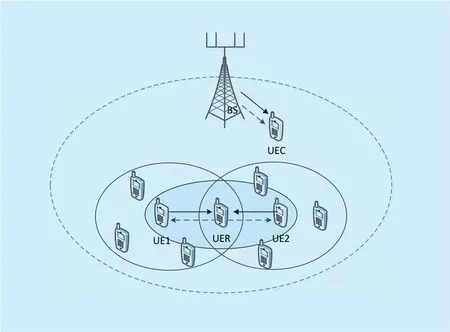
Fig. 1. D2D communication aided by a two-way DF relay node.
We adopt the following notations: The absolute value of a scalar is expressed aswhilereturns the norm of a vector. The superscript (·)His used to indicate the matrix conjugate transpose while ℂ denotes the complex space. Vectors are represented as columns and are denoted in lower case boldface. Finally, the symbol ~ denotes “distributed as”.
II. SYSTEM MODEL
Consider a D2D communication system underlying cellular networks assisted with a two-way DF relay node. As shown in figure 1, we consider an isolated cell including a base station(BS), one cellular user and a pair of D2D users(denoted as UEC, UE1, and UE2, respectively).Different from the traditional D2D communication, the D2D users exchange the signal with each other through a two-way DF relay node (UER). We propose the BS is equipped with M antennas while all the mobile users are equipped with single antenna. We denote the transmit power of terminal i as PiT, where i=B, C,1,2,R , which indicate BS, UEC, UE1,UE2, and UER, respectively. For fading channels, we use hBs∈ℂM×1to indicate the scalar channels between users while hBs∈ℂM×1stands for the channels between the BS and the users. The small-scale fading is assumed to follow a complex zero-mean Gaussian distribution with unit variance and satisfy hks=hskdue to reciprocity. The path loss factors are characterized by de fining d0, where d0is the reference distance, dij(j=B, C,1,2,R; j≠i )refers to the characterized distance between node i and node j, and α is the path-loss exponent. It is also assumed that Siis the normalized transmit symbols for node i, i.e.,Let nirepresent the zero-mean complex Gaussian noise with unit variance ex-perienced at node i.
In the downlink phase, the BS transmits its message-bearing signal SB1to UEC meanwhile UE1 and UE2 send their message-bearing signals S1and S2to UER via the direct links simultaneously. By sharing the same time-frequency resources with cellular users,the cellular link and D2D link interfere with each other. Thus, the received signal at UEC during the first downlink slot can be written as

where w is the precoding vector at the BS.For the second downlink slot, after the decoding process of yR, UER decodes the received signals S1and S2and retransmits the signal SRto the D2D users. At the same time, UEC is served by the BS with the messages-bearing signal SB2. Thus, the D2D link and the BSUEC link interfere with each other. Then, the received signal at UEC during the second downlink slot is given by


and

Note that the outage probability is de fined as the probability that the SINR γ falls below a present ratioγth. Then we can obtain the outage probability of the system by integrating the probability distribution function (CDF) of γththat


where Pij,tcorresponds to the outage probability of the i−j link during the t-th time slot.We will investigate the outage behavior in the following part as it is a key indicator of the system performance
III. OUTAGE PROBABILITY ANALYSIS
In this section, we consider the scenario that the M-antenna BS serves UEC by performing BF or IC strategies to reduce the interference between each link. We first analyze the distributions of received SINRs for each link. Then we derive the exact closed-form expressions to characterize the outage behavior for both D2D and cellular links. Symmetric (where the received power at UEC from two D2D users are the same) and asymmetric (where the received power at UEC are different) cases are discussed respectively. In this paper, we assume that perfect CSI is available at the BS.Before starting the investigation of the outage probability, we derive the following lemmas which will be proved useful in the subsequent derivations.
Lemma 1: For three random variables X,U, V wheredenotes a chisquare random variable with 2L degrees of freedom),and three constants a, b and c. By de finingandwe have

where
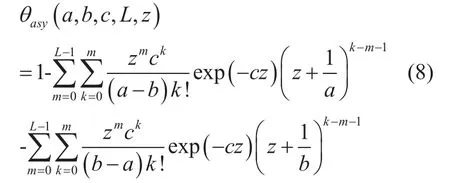
and

Proof: See Appendix I.
Lemma 2: For three random variables X,U, V whereand three constants a and b. By definingandwe have

Proof: According to the expression in(8), when b→0, we have 1/b→∞. Since k−m−1≤−1, it leads to

Then, we can arrive the result in Lemma 2.
Lemma 3: By de fining
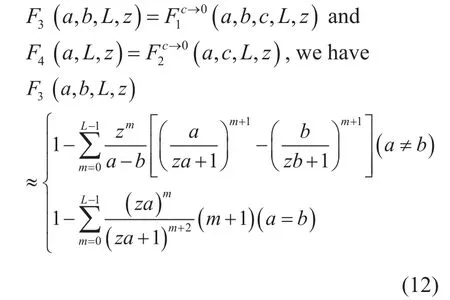
and

Proof: When c→0, we have c0=1 and ck→0 (k≥1). Then the expressions in Lemma 3 can be approximated.
The results in Lemma 1 - Lemma 3 will be used to derive the closed-form expressions of the outage behavior. Having these lemmas,we analyze the outage behaviors of each links subsequently.
3.1 Beamforming case
When the BS chose the BF strategy, the BS directly serves its own user UEC without doing interference cancellation for D2D users.Thus, the direction of the precoding vector w should be the same with the channel direction,i.e., for user i,Thereby we
have the following distribution

and

Then for the cellular link, the distribution of received SINR at URC in the first downlink slot (3) follows

and for the second downlink slot, we have

Having the aforementioned analysis, we derive the outage probability of the cellular link for the BF strategy.
Theorem 1: The outage probability of the cellular link for BF strategy with perfect CSI is given by

where

and

Proof: Based on the definition of outage probability for the cellular link in (6), by comparing the distributions of received SINR in(16) and (17) with the results in Lemma 1, it leads to the results in (18) directly.
Note that aBC, bBC, eBCstand for the ratio between interferences and desired signal from UE1, UE2 and UER respectively while cBCrefers to the noise-desired signal ratio. The term I1corresponds to the first downlink slot,as well as, term I2accounts the second slot.Theorem 1 provides a comprehensive charac-terization of the outage performance for the D2D communication assisted a two-way DF relay node which only involves standard functions that can be easily evaluated. According to Theorem 1, we find that the outage behavior depends on not only the desired signal PBTLBCand the interferences, but also the noise power N0and the threshold γth. Specifically,aBC,bBC,eBC→0 indicates the cellular link is far away from the D2D link and cBC→0 means the high SNR case.
For the high SNR case, we have cBC→0.Then based on the results in Lemma 3, we can obtain the simpler approximated expressions for high SNR case.

where

and

As expected, the additive noise is negligible leads to the nonexistence of the parameter N0.From (21), it shows the outage performance is a monotonic increasing function with γth.Now we explore the expressions in (12). When a≠b, F3( a, b, L, z ) can be expressed as
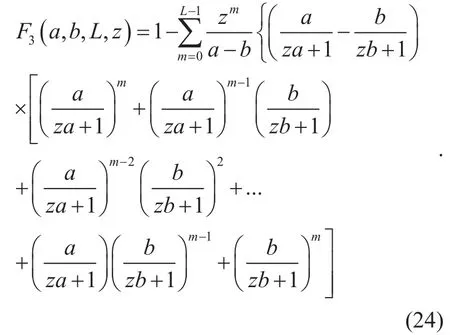
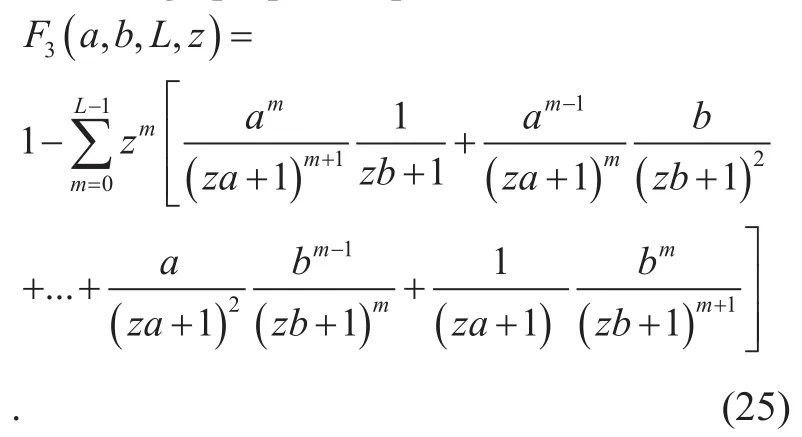
Through proper simpli fication, we have
We can easily find that, F3is a monotonous increasing function of a and b. That is to say,the outage performance can be improved by increase the desired signal between BS and UEC or decrease the interference from the D2D link.
3.2 Interference cancellation case

and

Similarly, according to the results in Lemma 1, we can easily derive the closed-form expressions for the outage probability of D2D link for the IC strategy.
Theorem 2: The outage probability of the cellular link for the IC strategy with perfect CSI is given by

where

and

Now we discuss the outage probability under high SNR case using IC strategy. Similarly, for the high SNR case, we have

where

and

Now we assume that
⑬参见张琳、东艳《主要发达经济体推行“竞争中立”原则的实践与比较》,《上海对外经贸大学学报》2015年第4期。

which can be transferred to

Note that (35) is a geometric progression and we can obtain that

Since q>0, we can easily find that whenThen, it yields

By combining (37) and (13), it is obviously that

Similarly, using the above solutions, we have

Apparently, having these results, we have

and

That is to say, when the BS is equipped with a large number of antennas, i.e., M→∞, the outage probability of the cellular link tends to be zero.
IV. NUMERICAL RESULTS
In this section, several numerical results areprovided to validate the accuracy of our analysis. For convenience, all the users are assumed to have the same transmit power and the transmit power of the BS is 20 times that of the users. An urban macro cell scenario is considered for the path-loss fading coefficient and the reference distance is set to be unity, i.e.,d0=1. The simulation parameters are shown in Table I. The Rayleigh channels are assumed to be independently and identically distributed. All the Monte-Carlo simulations results in this section are based on 106independent channel realizations.

TableI. Simulation parameters.
Figure 2 provides the analysis results under both BF and IC strategies in Theorem 1 and Theorem 2 for asymmetric case, respectively.The high SNR approximations for each strategies are also plotted. In order to verify the accuracy of our analysis results, the Monte-Carlo simulations are presented. In this figure,we assume the normalized distance between each user as d1c=2, d2c=3, dbc=4 and drc=2.5. The threshold is set as γth=0dB.We also assume the BS is equipped with 6 antennas, i.e., M=6. The outage probability are plotted as a function of SNR at the user. As anticipated, the figure shows the perfect agreement between the Monte-Carlo simulations and the analytical results across the whole SNR regime. The approximations for the high SNR case also match precisely with the Monte-Carlo simulations. Furthermore, it can be found that a cross point is exited in the figure which confirms the conclusion that: the BF strategy performs better than IC strategy in the high SNR regime, while IC strategy is always employed for the low SNR.
Figure 3 illustrates the results of the outage probability for the symmetric case. Here, we set d1c=d2c=drc=2, dbc=4 and M=7.For BF and IC strategies, the thresholds are assumed as 2dB and 0dB respectively. Again,we see the analysis results coincide with the Monte-Carlo simulations quite well and the high SNR approximations match exactly with Monte-Carlo results in the high SNR regime.Since the threshold for IC strategy is assumed lower than IC case, the outage probability for IC strategy is always better than BF case.
We compare the outage performance between relay-assisted D2D communication case and the traditional D2D communication case for the cellular link as shown in figure 4. In this figure, the outage performance is plotted against the distance between UE1 and UEC.We set SNR=20dB, M=4 and γth=0dB.We also assume the total transmit power of D2D link under two cases are the same, i.e.,

We can easily find that the outage performance of relay-assisted case always outperforms that of traditional case without extra power.When the distance between D2D user and cellular user is long enough, the interference form D2D link can be ignored, then the outage probability tends to be zero.
V. CONCLUSIONS
In this paper, the outage performance of D2D communication underlaying cellular network for BF and IC strategies with an M- antenna BS was investigated. The D2D users communicate with each other through a two-way DF relay node. The outage probabilities for both cellular and D2D links were analyzed for asymmetric and symmetric cases under BF and IC strategies, respectively. We derived closed-form exact expressions and their high SNR approximations for the outage probability. Based on these results, we showed the several main factors that in fluence the system performance. Numerical results are presented to validate the analysis, as well as, the asymptotic results.
Appendix
Proof of Lemma 1
By setting Y=aU+bV , we have

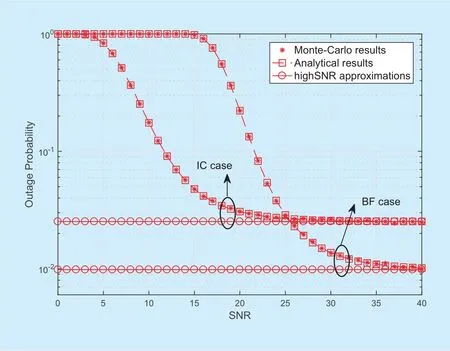
Fig. 2. Monte-Carlo results, analysis results and high SNR approximations for BF and IC strategies under asymmetric case.
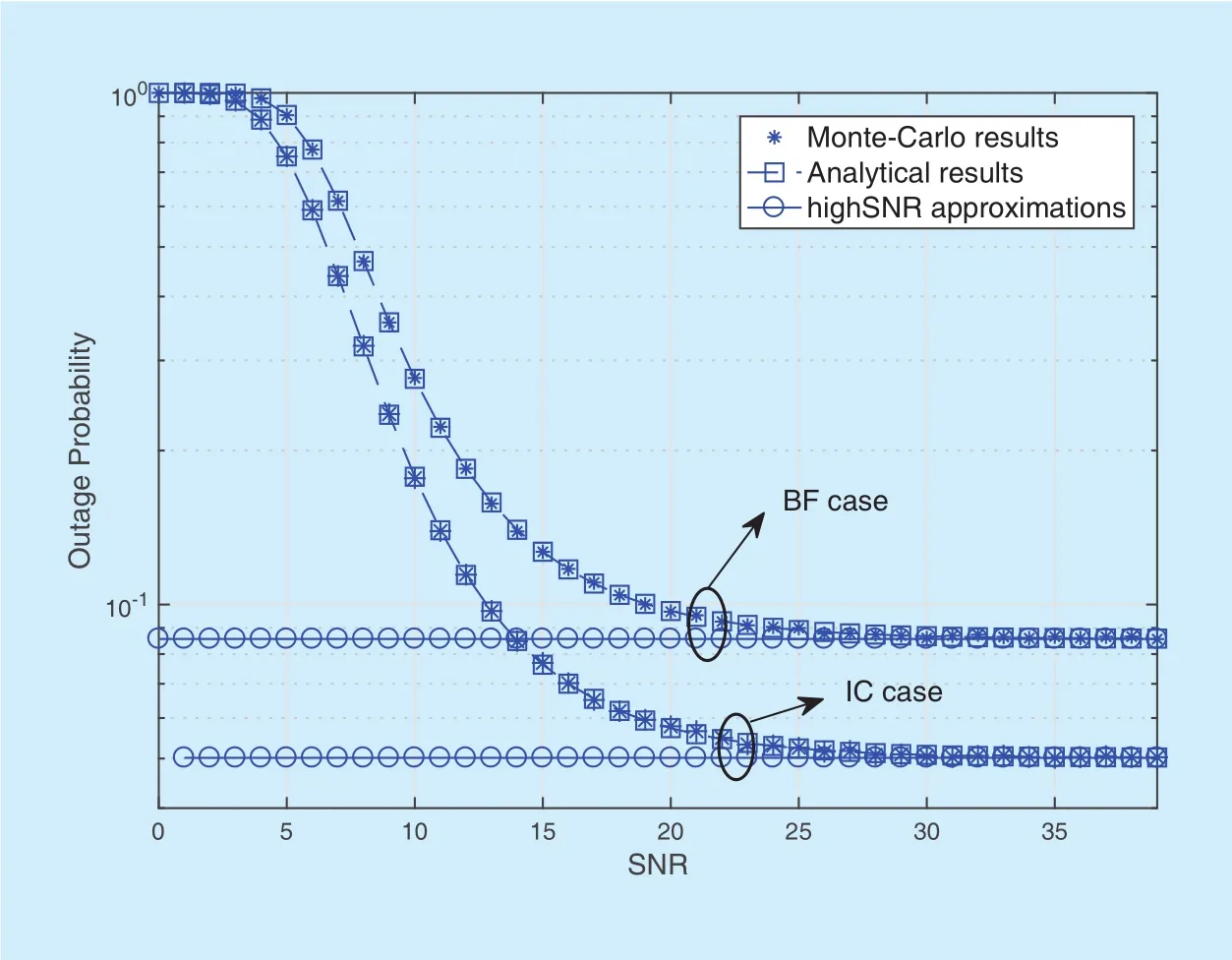
Fig. 3. Monte-Carlo results, analysis results and high SNR approximations for BF and IC strategies under symmetric case.
Then we can easily get


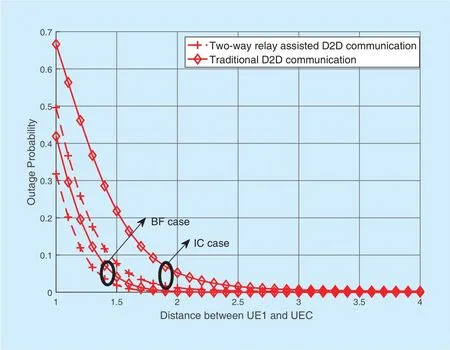
Fig. 4. Comparison of the outage performance between two-way DF relay assisted D2D communication case and traditional D2D communication case.
We set S=aU, T=bV, then we have Y=S+T. For Uand V, when a≠b, we can get

and

The PDF of Y can be written as

Since the random variables S, T are independent and satisfying S>0, T>0, we have

Then, we can easily obtain

By substituting (45) and (46) into (44), we have (51) shown in the bottom at this page.Note that term I1has a form similar to term I2, for the term I1, we have (52) shown in the bottom at this page. With the help of [44], it leads to (53) shown in the bottom at this page.According to the de finition of the incomplete gamma function for integer n that

I1can be expressed as
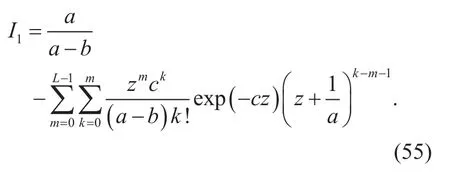
Similarly, we can easily obtain the expression of term I2
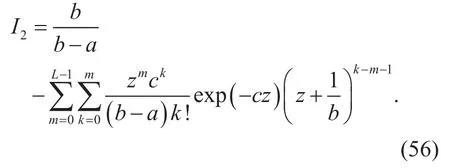
Based on the results in (55) and (56), it can easily arrive the result in (8).
When a=b, the same way, the PDF of Y can be given by

According to the equations in (44), (45) and(57), we have

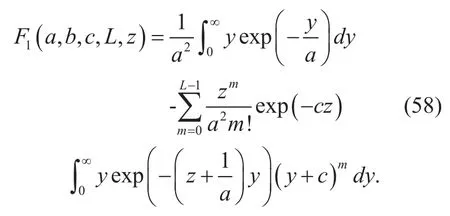
After some manipulations, (58) can be transferred into
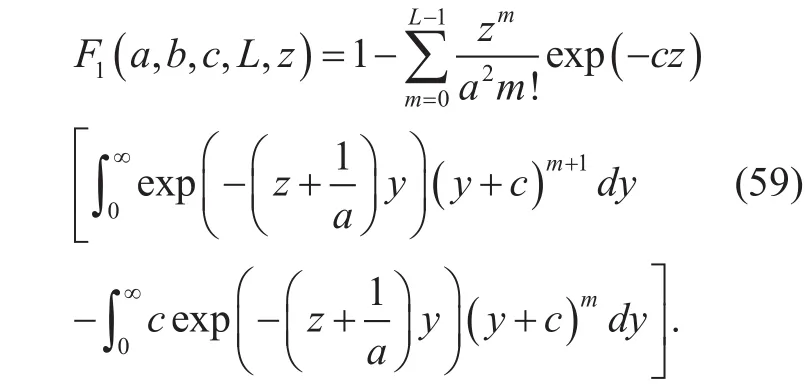
Then with the help of [43], it yields

Having (60), we can obtain the result in (9)after some manipulations.
ACKNOWLEDGEMENT
This work was supported by the National Science Foundation for Distinguished Young Scholars of China (No. 61701201), the Natural Science Foundation of Jiangsu Province(No. BK20170758, BK20170757), the Natural Science Foundation for colleges and universities of Jiangsu Province (No. 17KJB510011),Project of Key Laboratory of Wireless Communications of Jiangsu Province.
[1] Fodor G, Dahlman E, Mildh G, et al. Design aspects of network assisted device-to-device communications [J]. IEEE Commun. Magazine,2012, 50(3): 170-177.
[2] M. Bake. From LTE-Advanced to the future [J].IEEE Commun. Magazine, 2012, 50(2): 116-120.
[3] Yu C H, Doppler K, Ribeiro C B, et al. Device-to-device communication underlaying cellular communications system [J]. Int. J. Commun. Netw. System Sciences, 2009, 47(12): 42-49.
[4] Fodor G, Dahlman E, Mildh G, et al. Design aspects of network assisted device-to-device communications [J]. IEEE Commun. Magazine,2012, 50(3): 170-177.
[5] Zhang Z, Chai X, Long K, et al. Full duplex techniques for 5G networks: Self-interference cancellation, protocol design, and relay selection[J]. IEEE Commun. Magazine, 2015, 53(5): 128-137.
[6] Kuruvatti N P, Klein A, et al. Robustness of location based D2D resource allocation against positioning errors [C]. VTC-Spring, 2015.
[7] Doppler K, Rinne M P, Janis P, et al. Device-to-device communications: Functional prospects for LTE-advanced networks [C]. IEEE ICC, 2009: 1-6.
[8] Hakola S, Tao C, Lehtomaki J, et al. Device-to-device (D2D) communication in cellular network - Performance analysis of optimum and practical communication mode selection[C]. IEEE WCNC, 2010: 1-6.
[9] Lei L, Zhong Z D, Lin C, et al. Operator controlled device-to-device communications in LTE-advanced networks [J]. IEEE Wireless Commun., 2012, 19(3): 96-104.
[10] Ye Q, Al-Shalash M, Caramanis C, et al. Resource optimization in device-to-device cellular systems using time-frequency hopping [J]. IEEE Trans. Wireless Commun., 2014, 13(10): 5467-5480.
[11] Lei L, Zhong Z D, Lin C, et al. Operator controlled devie-to-device communications in LTE-advanced networks [J]. IEEE Wireless Commun.,2012, 19(3): 96-104.
[12] Asadi A, Wang Q and Mancuso V. A survey on device-to-device communication in cellular networks [J]. IEEE Commun. Surveys Tuts., 2013,16(3): 1801-1819.
[13] Sheng M, Liu J Y, Wang X J, et al. On transmission capacity region of D2D integrated cellular networks with interference management [J].IEEE Trans. Commun., 2015, 63(4): 1383-1399.
[14] Yu C H, Tirrkonen O, Doppler K, et al. Power optimization of device-to-device communication underlaying cellular communication [C]. IEEE ICC, 2009: 1-6.
[15] Laneman J N, Wornell G W, Tse D N C. Cooperative diversity in wireless networks: efficient protocols and outage behavior [J]. IEEE Trans.Info. Theory, 2004, 50(12): 3062-3080.
[16] Bolcskei H, Nabar R U, Oyman O, et al. Capacity scaling laws in MIMO relay networks [J]. IEEE Trans. Wireless Commun., 2006, 5(6): 1433-1444.
[17] Huang G, Wang Y, Coon J. Performance of multihop decode-and-forward and amplify-andforward delay networks with channel estimation[C]. IEEE PacRim, 2007: 352--357.
[18] Zhong C, Jin S, Wong K K. Dual-hop systems with noisy relay and interference-limited des-tination [J]. IEEE Trans. Commun. Society, 2010,58(3): 764--768.
[19] Rankov B, Wittneben A. Spectral eきcient protocols for half-duplex fading relay channels [J].IEEE J. Sel. Areas Commun., 2007, 25(2): 379--389.
[20] Cover T M, Gamal A E. Capacity theorems for the relay channel [J]. IEEE Trans. Inf. Theory,1979, 25(4): 572--584.
[21] Louie R H Y, Li Y H, Vucetic B. Practical Physical Layer Network Coding for Two-Way Relay Channels: Performance Analysis and Comparison [J]. IEEE Trans. Wireless Commun., 2010,9(2): 764-777.
[22] Saliya Jayasinghe L K, Jayasinghe P, Rajatheva N, et al. MIMO physical layer network coding based underlay device-to-device communication [C]. IEEE PMIRC, 2013: 89-94.
[23] Hasan M, Hossain E. Distributed resource allocation for relay-aided device-to-device communication: A message passing approach [J]. IEEE Trans. Wireless Commun., 2014, 13(11): 6326-6341..
[24] Hoang T, Le B L, Le-Ngoc T. Joint mode selection and resource allocation for relay-based D2D communications [J]. IEEE Commun. Letters,2017, 21(2): 398-401.
[25] Zhao M, Gu X Y, Wu D, et al. A two-stages relay selection and resource allocation joint method for D2D communication system [C]. IEEE WCNC,2016: 1-6.
[26] Zhou B, Hu H L, Huang S Q, et al. Intracluster device-to-device relay algorithm with optimal resource utilization [J]. IEEE Trans. Veh. Tech.,2013, 62(5): 2315-2326.
[27] Jindal N, Goldsmith A. Dirty paper coding versus TDMA for MIMO broadcast channels [J].IEEE Trans. Inf. Theory, 2005, 51(5): 1783-1794.
[28] Zhong W, Fang Y X, Jin S, et al. Joint resource allocation for device-to-device communications underlaying uplink MIMO cellular networks [J].IEEE J. Sel. Areas Commun., 2015, 33(1):41-54.
[29] Ramezani-Kebrya A, Dong M, Liang B, et al.Optimal power allocation in device-to-device communication with SIMO uplink beamforming[C]. IEEE SPAWC, 2015: 425-429.
[30] Fang B, Qian Z P, Zhong W, et al. Coordinated precoding for D2D communications underlay uplink MIMO cellular networks [C]. IEEE ICCC,2015: 425-429.
[31] Senadhira N, Guo J, Durrani S. Outage analysis of underlaid multi-antenna D2D communication in cellular networks [C]. ICSPCS, 2016: 1-7.
[32] Lin X Q, Heath Jr R W, Andrews J G. The interplay between massive MIMO and underlaid D2D networking [J]. IEEE Trans. Wireless Commun., 2015, 14(6): 3337-3351.
[33] Wei L L, Hu Q Y, He T, et al. Device-to-device communication underlaying MU-MIMO cellular networks [J]. IEEE GLOBECOM, 2013:4902-4907.[34] Amin B S, Ramadan Y R, Ibrahim A S, et al. Power allocation for device-to-device communication underlaying massive MIMO multicasting networks [C]. IEEE WCNC, 2015:1219-1224.
[35] Sun H J, Xu Y R, Hu Q Y. A NOMA and MU-MIMO supported cellular network with underlaid D2D communications [C]. IEEE VTC-Spring,2016:1-5.
[36] Lin M, Ouyang J, Zhu W P. Joint beamforming and power control for device-to-device communications underlaying cellular networks [J].IEEE J. Sel. Areas Commun., 2016, 34(1):138-150.
[37] Xu C, Song L Y, Zhang Y J. MU-MIMO resource optimization for device-to-device underlay downlink cellular networks [C]. IEEE GLOBECOM, 2015:1-6.
[38] Lin J R, Shi Q J, Li Q. Joint device-to-device transmission activation and transceiver design for sum-rate maximization in MIMO interfering channels [C]. IEEE ICASSP, 2016:3921-3925.
[39] Hwang D, Kim D I, Choi S K, et al. UE relaying cooperation over D2D uplink in heterogeneous cellular networks [J]. IEEE Trans. Commun., 2015,63(12):4784-4796.
[40] Qin Y, Ding M, Zhang M, et al. Relaying robust beamforming for device-to-device communication with channel uncertainty [J]. IEEE Commun.Letters, 2014, 18(10):1859-1862.
[41] Shi F F, Xu W, Shen H, et al. Coordinated adaptive control in device-to-device communications based on delayed limited feedback [C].IEEE VTC-Fall, 2014:1-6.
[42] Ni Y Y, Jin S, Xu W, et al. Beamforming and interference cancellation for D2D communication underlaying cellular networks [J]. IEEE Trans.Commun., 2016, 64(2):832-846.
[43] Gradshteyn I S, Ryzhik I M. Table of Integrals,Series, and Products [M]. 6th ed., San Diego,California: Academic Press, 2000.
[44] Abramowitz M, Stegun I A. Handbook of Mathematical Functions with Formulas, Graphs, and Mathematical Tables [M]. 10th ed., San Diego,California: Academic Press, 1972.
猜你喜欢
杂志排行
China Communications的其它文章
- Stochastic Dynamic Modeling of Rain Attenuation: A Survey
- Heuristic Solutions of Virtual Network Embedding: A Survey
- A Survey on Smart Collaborative Identi fier Networks
- Service Function Chain in Small Satellite-Based Software De fined Satellite Networks
- Coordinated Resource Allocation for Satellite-Terrestrial Coexistence Based on Radio Maps
- A Novel Roll Compensation Method for Two-Axis Transportable Satellite Antennas
